Pore Structure and Fractal Characteristics of Marine–Continental Transitional Black Shales: A Case Study of the Permian Shanxi Formation in the Eastern Margin of the Ordos Basin
Abstract
1. Introduction
2. Geological Setting
3. Samples and Methods
3.1. Samples
3.2. Organic Petrography and Mineralogy
3.3. FE-SEM
3.4. Gas Adsorption Measurements
3.5. CH4 Isothermal Adsorption
3.6. Fractal Theory
4. Results
4.1. Mineralogy and Geochemistry
4.2. Pore Characteristics from FE-SEM
4.3. Pore Characteristics from Gas Adsorption
4.3.1. Low-Temperature N2 Adsorption
4.3.2. Low-Pressure CO2 Adsorption
4.4. CH4 Adsorption Isotherms
4.5. Pore Fractal Characteristics
5. Discussion
5.1. Properties of the Porous Structure Distribution
5.2. The Relevance of Pore Structure to Shale Composition
5.3. Dimensions of Fractals and Their Influences
5.4. Connections between the Langmuir Parameters for CH4 Adsorption and the Fractal Dimension
6. Conclusions
Author Contributions
Funding
Data Availability Statement
Acknowledgments
Conflicts of Interest
References
- Adeyilola, A.; Nordeng, S.; Onwumelu, C.; Nwachukwu, F.; Gentzis, T. Geochemical, Petrographic and Petrophysical Characterization of the Lower Bakken Shale, Divide County, North Dakota. Int. J. Coal Geol. 2020, 224, 103477. [Google Scholar] [CrossRef]
- Zou, C.; Yang, Z.; He, D.; Wei, Y.; Li, J.; Jia, A.; Chen, J.; Zhao, Q.; Li, Y.; Li, J.; et al. Theory, Technology and Prospects of Conventional and Unconventional Natural Gas. Pet. Explor. Dev. 2018, 45, 604–618. [Google Scholar] [CrossRef]
- Zou, C.; Zhang, G.; Yang, Z.; Tao, S.; Hou, L.; Zhu, R.; Yuan, X.; Ran, Q.; Li, D.; Wang, Z. Concepts, Characteristics, Potential and Technology of Hydrocarbons: On Unconventional Petroleum Geology. Pet. Explor. Dev. 2013, 40, 413–428. [Google Scholar] [CrossRef]
- Wang, H.; Shi, Z.; Wang, Q.; Zhao, Q.; Dong, D.; Li, S.; Liu, D.; Sun, S.; Qiu, Z. Favorable Lithofacies Types and Genesis of Marine-Continental Transitional Black Shale: A Case Study of Permian Shanxi Formation in the Eastern Margin of Ordos Basin, NW China. Pet. Explor. Dev. 2021, 48, 1315–1328. [Google Scholar]
- Li, A.; Ding, W.; He, J.; Dai, P.; Yin, S.; Xie, F. Investigation of Pore Structure and Fractal Characteristics of Organic-Rich Shale Reservoirs: A Case Study of Lower Cambrian Qiongzhusi Formation in Malong Block of Eastern Yunnan Province, South China. Mar. Pet. Geol. 2016, 70, 46–57. [Google Scholar] [CrossRef]
- Ji, W.; Song, Y.; Jiang, Z.; Meng, M.; Liu, Q.; Chen, L.; Wang, P.; Gao, F.; Huang, H. Fractal Characteristics of Nano-Pores in the Lower Silurian Longmaxi Shales from the Upper Yangtze Platform, South China. Mar. Pet. Geol. 2016, 78, 88–98. [Google Scholar] [CrossRef]
- Li, Y.; Wang, Z.; Pan, Z.; Niu, X.; Yu, Y.; Meng, S. Pore Structure and Its Fractal Dimensions of Transitional Shale: A Cross-Section from East Margin of the Ordos Basin, China. Fuel 2019, 241, 417–431. [Google Scholar] [CrossRef]
- Kuang, L.; Dong, D.; He, W.; Wen, S.; Sun, S.; Li, S.; Qiu, Z.; Liao, X.; Li, Y.; Wu, J.; et al. Geological Characteristics and Development Potential of Transitional Shale Gas in the East Margin of the Ordos Basin, NW China. Pet. Explor. Dev. 2020, 47, 471–482. [Google Scholar] [CrossRef]
- Xie, W.D.; Wang, M.; Wang, X.Q.; Wang, Y.D.; Hu, C.Q. Nano-Pore Structure and Fractal Characteristics of Shale Gas Reservoirs: A Case Study of Longmaxi Formation in Southeastern Chongqing, China. J. Nanosci. Nanotechnol. 2021, 21, 343–353. [Google Scholar] [CrossRef]
- Zhou, S.; Liu, D.; Cai, Y.; Yao, Y.; Li, Z. 3D Characterization and Quantitative Evaluation of Pore-Fracture Networks of Two Chinese Coals Using FIB-SEM Tomography. Int. J. Coal Geol. 2017, 174, 41–54. [Google Scholar] [CrossRef]
- Sing, K. The Use of Nitrogen Adsorption for the Characterisation of Porous Materials. Colloid Surf. A 2001, 187–188, 3–9. [Google Scholar] [CrossRef]
- Wang, G.; Zhang, Q.; Zhu, R.; Tang, X.; Liu, K.; Jin, Z. Geological Controls on the Pore System of Lacustrine Unconventional Shale Reservoirs: The Triassic Chang 7 Member in the Ordos Basin, China. Geoenergy Sci. Eng. 2023, 221, 111139. [Google Scholar] [CrossRef]
- Wang, J.Y.; Guo, S.B. Study on the Relationship between Hydrocarbon Generation and Pore Evolution in Continental Shale from the Ordos Basin, China. Pet. Sci. 2021, 18, 1305–1322. [Google Scholar] [CrossRef]
- Al-Yaseri, A.Z.; Lebedev, M.; Vogt, S.J.; Johns, M.L.; Barifcani, A.; Iglauer, S. Pore-Scale Analysis of Formation Damage in Bentheimer Sandstone with in-Situ NMR and Micro-Computed Tomography Experiments. J. Pet. Sci. Eng. 2015, 129, 48–57. [Google Scholar] [CrossRef]
- Wang, T.; Tian, F.; Deng, Z.; Hu, H. Pore Structure and Fractal Characteristics of Wufeng–Longmaxi Formation Shale in Northern Yunnan–Guizhou, China. Front. Earth Sci. 2023, 10, 998958. [Google Scholar] [CrossRef]
- Han, H.; Guo, C.; Zhong, N.; Pang, P.; Gao, Y. A Study on Fractal Characteristics of Lacustrine Shales of Qingshankou Formation in the Songliao Basin, Northeast China Using Nitrogen Adsorption and Mercury Injection Methods. J. Pet. Sci. Eng. 2020, 193, 107378. [Google Scholar] [CrossRef]
- Li, Z.; Liu, D.; Cai, Y.; Ranjith, P.G.; Yao, Y. Multi-Scale Quantitative Characterization of 3-D Pore-Fracture Networks in Bituminous and Anthracite Coals Using FIB-SEM Tomography and X-Ray μ-CT. Fuel 2017, 209, 43–53. [Google Scholar] [CrossRef]
- Liu, K.; Ostadhassan, M.; Zhou, J.; Gentzis, T.; Rezaee, R. Nanoscale Pore Structure Characterization o f the Bakken Shale in the USA. Fuel 2017, 209, 567–578. [Google Scholar] [CrossRef]
- Mastalerz, M.; He, L.; Melnichenko, Y.B.; Rupp, J.A. Porosity of Coal and Shale: Insights from Gas Adsorption and SANS/USANS Techniques. Energ Fuel 2012, 26, 5109–5120. [Google Scholar] [CrossRef]
- Zhang, J.; Tang, Y.; He, D.; Sun, P.; Zou, X. Full-Scale Nanopore System and Fractal Characteristics of Clay-Rich Lacustrine Shale Combining FE-SEM, Nano-CT, Gas Adsorption and Mercury Intrusion Porosimetry. Appl. Clay Sci. 2020, 196, 105758. [Google Scholar] [CrossRef]
- Yang, R.; He, S.; Yi, J.; Hu, Q. Nano-Scale Pore Structure and Fractal Dimension of Organic-Rich Wufeng-Longmaxi Shale from Jiaoshiba Area, Sichuan Basin: Investigations Using FE-SEM, Gas Adsorption and Helium Pycnometry. Mar. Pet. Geol. 2016, 70, 27–45. [Google Scholar] [CrossRef]
- Ahmadi, Y. Improving Fluid Flow through Low Permeability Reservoir in the Presence of Nanoparticles: An Experimental Core Flooding WAG Tests. Iran. J. Oil Gas Sci. Technol. 2021, 10, 69–82. [Google Scholar]
- Chen, S.; Tao, S.; Tang, D.; Xu, H.; Li, S.; Zhao, J.; Jiang, Q.; Yang, H. Pore Structure Characterization of Different Rank Coals Using N2 and CO2 Adsorption and Its Effect on CH4 Adsorption Capacity: A Case in Panguan Syncline, Western Guizhou, China. Energ Fuel 2017, 31, 6034–6044. [Google Scholar] [CrossRef]
- Mandelbrot, B.B.; Wheeler, J.A. The Fractal Geometry of Nature. Am. J. Phys. 1983, 51, 286–287. [Google Scholar] [CrossRef]
- Pfeifer, P.; Avnir, D. Chemistry in Noninteger Dimensions between Two and Three. I. Fractal Theory of Heterogeneous Surfaces. J. Chem. Phys. 1983, 79, 3558–3565. [Google Scholar] [CrossRef]
- Hazra, B.; Wood, D.A.; Vishal, V.; Varma, A.K.; Sakha, D.; Singh, A.K. Porosity Controls and Fractal Disposition of Organic-Rich Permian Shales Using Low-Pressure Adsorption Techniques. Fuel 2018, 220, 837–848. [Google Scholar] [CrossRef]
- Chandra, D.; Vishal, V.; Bahadur, J.; Sen, D. A Novel Approach to Identify Accessible and Inaccessible Pores in Gas Shales Using Combined Low-Pressure Sorption and SAXS/SANS Analysis. Int. J. Coal Geol. 2020, 228, 103556. [Google Scholar] [CrossRef]
- Li, Y.; Zhou, D.H.; Wang, W.H.; Jiang, T.X.; Xue, Z.J. Development of Unconventional Gas and Technologies Adopted in China. Energy Geosci. 2020, 1, 55–68. [Google Scholar] [CrossRef]
- Clarkson, C.R.; Solano, N.; Bustin, R.M.; Bustin, A.M.M.; Chalmers, G.R.L.; He, L.; Melnichenko, Y.B.; Radliński, A.P.; Blach, T.P. Pore Structure Characterization of North American Shale Gas Reservoirs Using USANS/SANS, Gas Adsorption, and Mercury Intrusion. Fuel 2013, 103, 606–616. [Google Scholar] [CrossRef]
- Chen, S.B.; Zhu, Y.M.; Wang, H.Y.; Liu, H.L.; Wei, W.; Fang, J.H. Structure characteristics and accumulation significance of nanopores in Longmaxi shale gas reservoir in the southern Sichuan. Basin. J. China Coal Soc. 2012, 37, 438–444. [Google Scholar]
- Tian, H.; Zhang, S.C.; Liu, S.B.; Zhang, H. Determination of organic-rich shale pore features by mercury injection and gas adsorption methods. Acta Pet. Sin. 2012, 33, 419–427. [Google Scholar]
- Wang, Y.; Zhu, Y.; Liu, S.; Zhang, R. Pore Characterization and Its Impact on Methane Adsorption Capacity for Organic-Rich Marine Shales. Fuel 2016, 181, 227–237. [Google Scholar] [CrossRef]
- Yang, R.; He, S.; Hu, Q.; Hu, D.; Zhang, S.; Yi, J. Pore Characterization and Methane Sorption Capacity of Over-Mature Organic-Rich Wufeng and Longmaxi Shales in the Southeast Sichuan Basin, China. Mar. Pet. Geol. 2016, 77, 247–261. [Google Scholar] [CrossRef]
- Zhang, P.; Huang, Y.; Zhang, J.; Tang, X.; Liu, C.; Yang, J. Fractal characteristics of the Longtan Formation transitional shale in northwest Guizhou. J. China Coal Soc. 2018, 43, 1580–1588. [Google Scholar]
- Huang, Y.Q.; Zhang, P.; Zhang, J.C.; Yang, J.Y. The effect on the fractal characteristics of shale pores by mineral compositions of marine and marine-continental transitional shales. Bull. Mineral. Petrol. Geochem. 2020, 39, 548–557. [Google Scholar]
- Yang, Y.; Zhang, J.; Xu, L.; Li, P.; Liu, Y.; Dang, W. Pore Structure and Fractal Characteristics of Deep Shale: A Case Study from Permian Shanxi Formation Shale, from the Ordos Basin. Acs Omega 2022, 7, 9229–9243. [Google Scholar] [CrossRef]
- Qiu, Z.; Song, D.; Zhang, L.; Zhang, Q.; Zhao, Q.; Wang, Y.; Liu, H.; Liu, D.; Li, S.; Li, X. The Geochemical and Pore Characteristics of a Typical Marine–Continental Transitional Gas Shale: A Case Study of the Permian Shanxi Formation on the Eastern Margin of the Ordos Basin. Energy Rep. 2021, 7, 3726–3736. [Google Scholar] [CrossRef]
- Zhang, Q.; Qiu, Z.; Zhao, Q.; Zhang, L.; Dong, D.; Wang, Y.; Hou, W.; Li, S.; Li, X. Composition Effect on the Pore Structure of Transitional Shale: A Case Study of the Permian Shanxi Formation in the Daning–Jixian Block at the Eastern Margin of the Ordos Basin. Front. Earth Sci. 2022, 9, 802713. [Google Scholar] [CrossRef]
- Yang, C.; Zhang, J.; Wang, X.; Tang, X.; Chen, Y.; Jiang, L.; Gong, X. Nanoscale Pore Structure and Fractal Characteristics of a Marine-Continental Transitional Shale: A Case Study from the Lower Permian Shanxi Shale in the Southeastern Ordos Basin, China. Mar. Pet. Geol. 2017, 88, 54–68. [Google Scholar] [CrossRef]
- Shan, C.; Zhao, W.; Wang, F.; Zhang, K.; Feng, Z.; Guo, L.; Ma, X.; Liao, T. Nanoscale Pore Structure Heterogeneity and Its Quantitative Characterization in Chang7 Lacustrine Shale of the Southeastern Ordos Basin, China. J. Pet. Sci. Eng. 2020, 187, 106754. [Google Scholar] [CrossRef]
- Brunauer, S.; Emmett, P.H.; Teller, E. Adsorption of Gases in Multimolecular Layers. J. Am. Chem. Soc. 1938, 60, 309–319. [Google Scholar] [CrossRef]
- Meng, M.; Ge, H.; Shen, Y.; Ji, W. Fractal Characterization of Pore Structure and Its Influence on Salt Ion Diffusion Behavior in Marine Shale Reservoirs. Int. J. Hydrogen Energy 2020, 45, 28520–28530. [Google Scholar] [CrossRef]
- Loucks, R.G.; Ruppel, S.C. Mississippian Barnett Shale: Lithofacies and Depositional Setting of a Deep-Water Shale-Gas Succession in the Fort Worth Basin, Texas. Aapg Bull. 2007, 91, 579–601. [Google Scholar] [CrossRef]
- Li, X.; Wang, Y.; Lin, W.; Ma, L.; Liu, D.; Liu, J.; Zhang, Y. Micro-Pore Structure and Fractal Characteristics of Deep Shale from Wufeng Formation to Longmaxi Formation in Jingmen Exploration Area, Hubei Province, China. J. Nat. Gas Geosci. 2022, 7, 121–132. [Google Scholar] [CrossRef]
- Wang, X.; Zhu, Y.; Wang, Y. Fractal Characteristics of Micro- and Mesopores in the Longmaxi Shale. Energies 2020, 13, 1349. [Google Scholar] [CrossRef]
- Wang, M.; Xue, H.; Tian, S.; Wilkins, R.W.T.; Wang, Z. Fractal Characteristics of Upper Cretaceous Lacustrine Shale from the Songliao Basin, NE China. Mar. Pet. Geol. 2015, 67, 144–153. [Google Scholar] [CrossRef]
- Goral, J.; Walton, I.; Andrew, M.; Deo, M. Pore System Characterization of Organic-Rich Shales Using Nanoscale-Resolution 3D Imaging. Fuel 2019, 258, 116049. [Google Scholar] [CrossRef]
- Josh, M.; Delle Piane, C.; Esteban, L.; Bourdet, J.; Mayo, S.; Pejcic, B.; Burgar, I.; Luzin, V.; Clennell, M.B.; Dewhurst, D.N. Advanced Laboratory Techniques Characterising Solids, Fluids and Pores in Shales. J. Pet. Sci. Eng. 2019, 180, 932–949. [Google Scholar] [CrossRef]
- Liu, X.; Xiong, J.; Liang, L. Investigation of Pore Structure and Fractal Characteristics of Organic-Rich Yanchang Formation Shale in Central China by Nitrogen Adsorption/Desorption Analysis. J. Nat. Gas Sci. Eng. 2015, 22, 62–72. [Google Scholar] [CrossRef]
- Sing, K.S.W. Reporting Physisorption Data for Gas/Solid Systems with Special Reference to the Determination of Surface Area and Porosity (Recommendations 1984). Pure Appl. Chem. 1985, 57, 603–619. [Google Scholar] [CrossRef]
- Peng, N.; He, S.; Hu, Q.; Zhang, B.; He, X.; Zhai, G.; He, C.; Yang, R. Organic Nanopore Structure and Fractal Characteristics of Wufeng and Lower Member of Longmaxi Shales in Southeastern Sichuan, China. Mar. Pet. Geol. 2019, 103, 456–472. [Google Scholar] [CrossRef]
- Wang, Y.; Zhu, Y.; Wang, H.; Feng, G. Nanoscale Pore Morphology and Distribution of Lacustrine Shale Reservoirs: Examples from the Upper Triassic Yanchang Formation, Ordos Basin. J. Energy Chem. 2015, 24, 512–519. [Google Scholar] [CrossRef]
- Thommes, M.; Kaneko, K.; Neimark, A.V.; Olivier, J.P.; Rodriguez-Reinoso, F.; Rouquerol, J.; Sing, K.S.W. Physisorption of Gases, with Special Reference to the Evaluation of Surface Area and Pore Size Distribution (IUPAC Technical Report). Pure Appl. Chem. 2015, 87, 1051–1069. [Google Scholar] [CrossRef]
- Wang, X.; Jiang, Z.; Jiang, S.; Chang, J.; Zhu, L.; Li, X.; Li, J. Full-Scale Pore Structure and Fractal Dimension of the Longmaxi Shale from the Southern Sichuan Basin: Investigations Using FE-SEM, Gas Adsorption and Mercury Intrusion Porosimetry. Minerals 2019, 9, 543. [Google Scholar] [CrossRef]
- Hu, J.; Tang, S.; Zhang, S. Investigation of Pore Structure and Fractal Characteristics of the Lower Silurian Longmaxi Shales in Western Hunan and Hubei Provinces in China. J. Nat. Gas Sci. Eng. 2016, 28, 522–535. [Google Scholar] [CrossRef]
- Sun, M.; Yu, B.; Hu, Q.; Chen, S.; Xia, W.; Ye, R. Nanoscale Pore Characteristics of the Lower Cambrian Niutitang Formation Shale: A Case Study from Well Yuke #1 in the Southeast of Chongqing, China. Int. J. Coal Geol. 2016, 154–155, 16–29. [Google Scholar]
- Milliken, K.L.; Rudnicki, M.; Awwiller, D.N.; Zhang, T. Organic Matter–Hosted Pore System, Marcellus Formation (Devonian), Pennsylvania. AAPG Bull. 2013, 97, 177–200. [Google Scholar] [CrossRef]
- Chang, J.; Fan, X.; Jiang, Z.; Wang, X.; Chen, L.; Li, J.; Zhu, L.; Wan, C.; Chen, Z. Differential Impact of Clay Minerals and Organic Matter on Pore Structure and Its Fractal Characteristics of Marine and Continental Shales in China. Appl. Clay Sci. 2022, 216, 106334. [Google Scholar] [CrossRef]
- Loucks, R.G.; Reed, R.M.; Ruppel, S.C.; Hammes, U. Spectrum of Pore Types and Networks in Mudrocks and a Descriptive Classification for Matrix-Related Mudrock Pores. Aapg Bull. 2012, 96, 1071–1098. [Google Scholar] [CrossRef]
- Kumar, S.; Mendhe, V.A.; Kamble, A.D.; Varma, A.K.; Mishra, D.K.; Bannerjee, M.; Buragohain, J.; Prasad, A.K. Geochemical Attributes, Pore Structures and Fractal Characteristics of Barakar Shale Deposits of Mand-Raigarh Basin, India. Mar. Pet. Geol. 2019, 103, 377–396. [Google Scholar] [CrossRef]
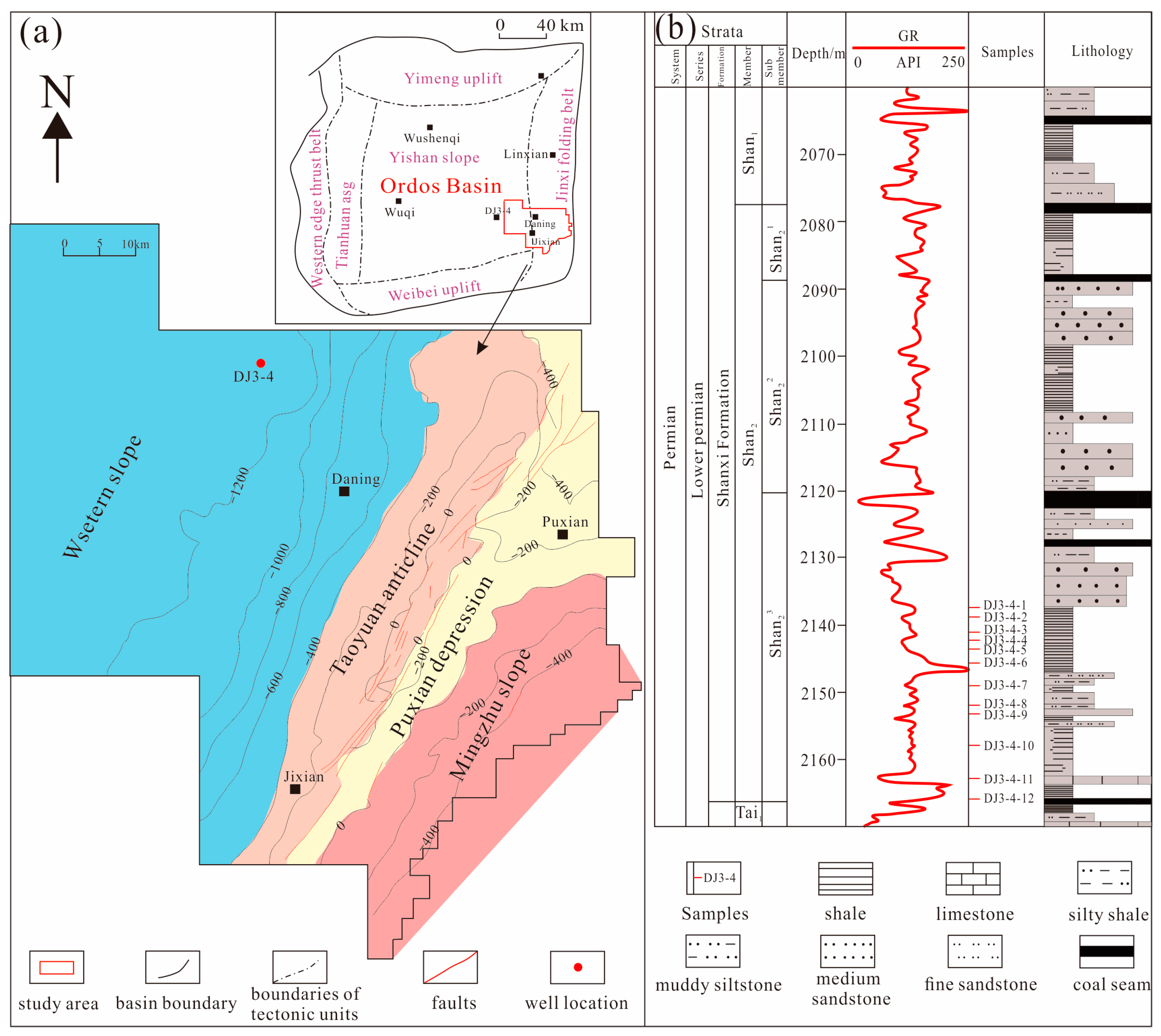



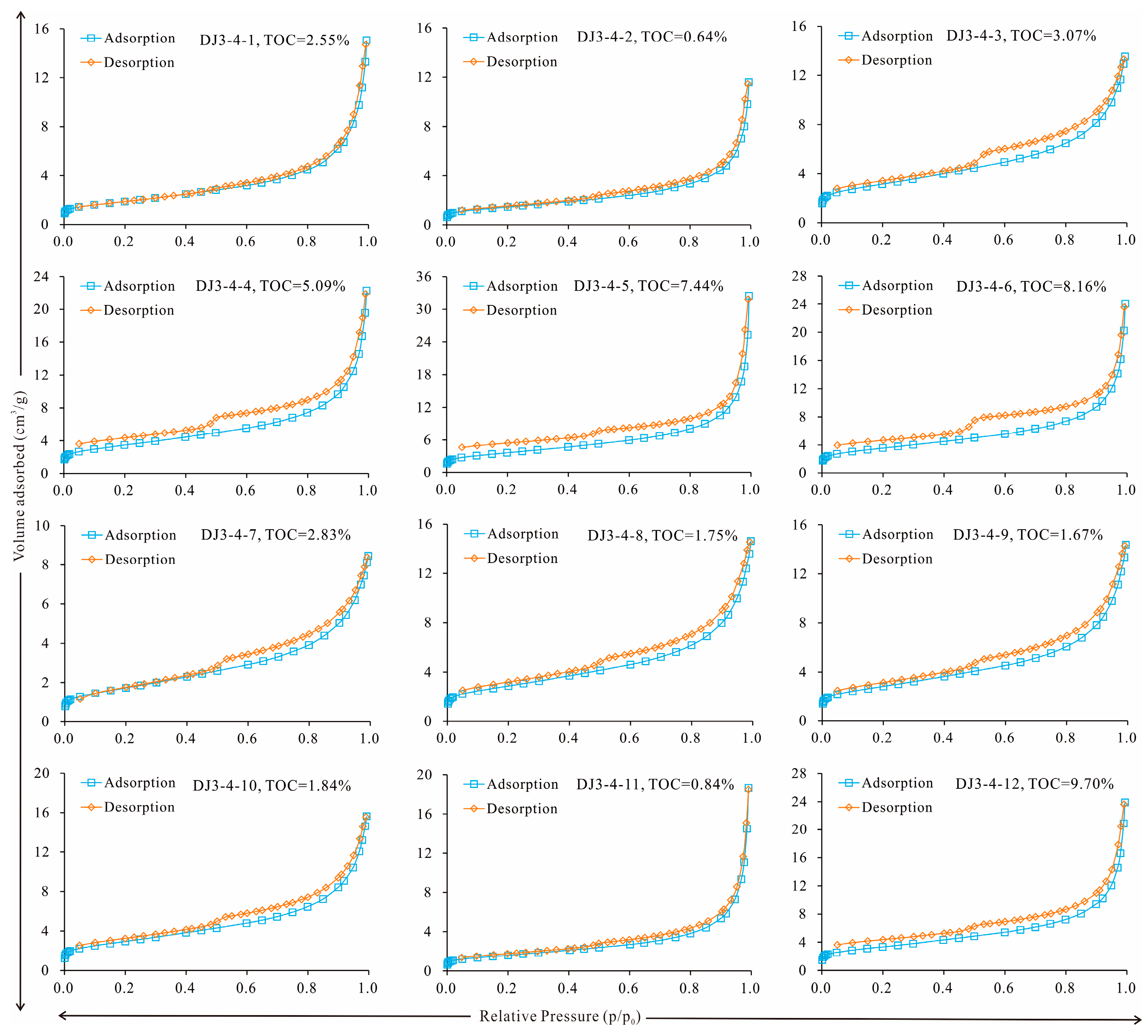
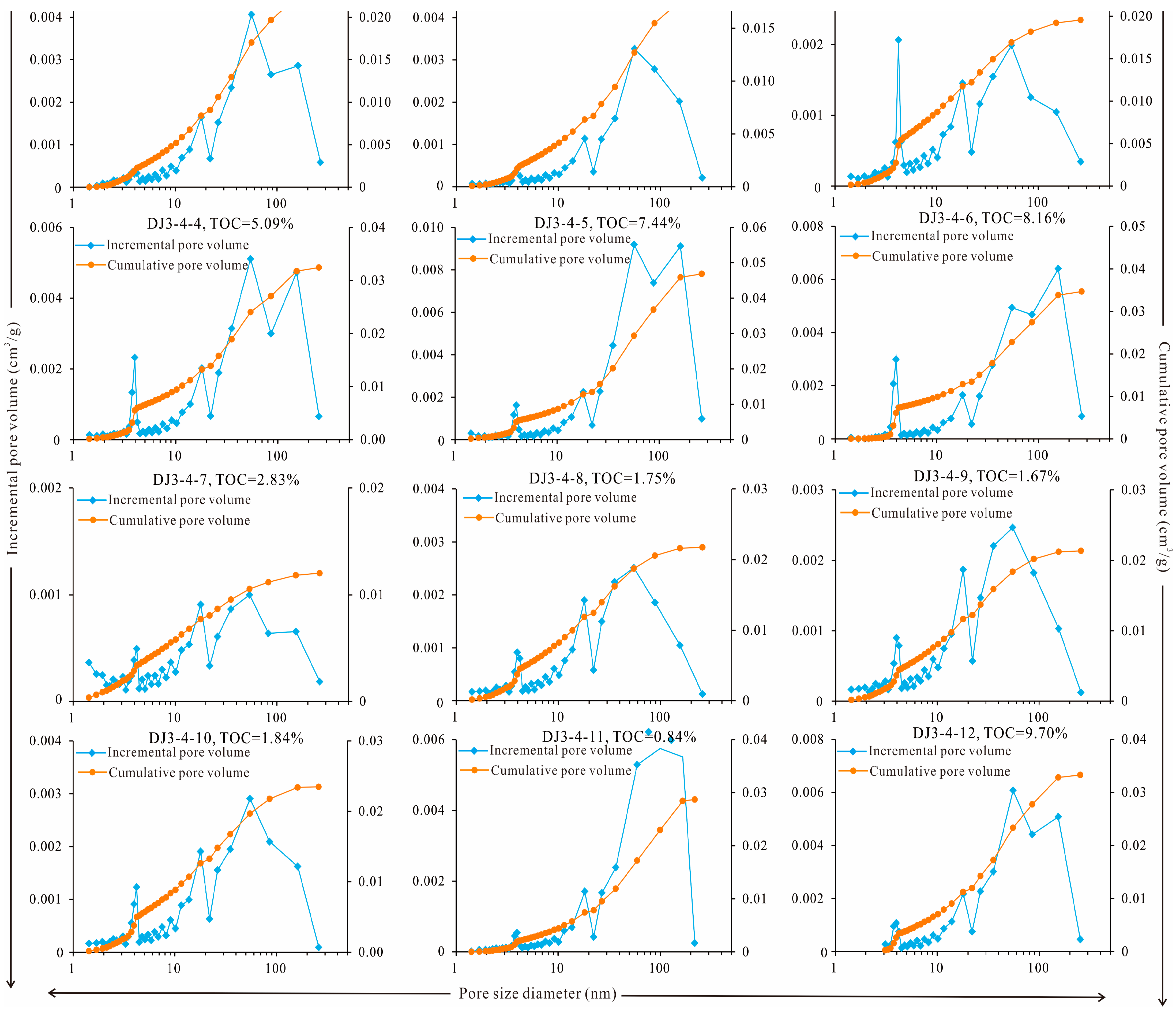
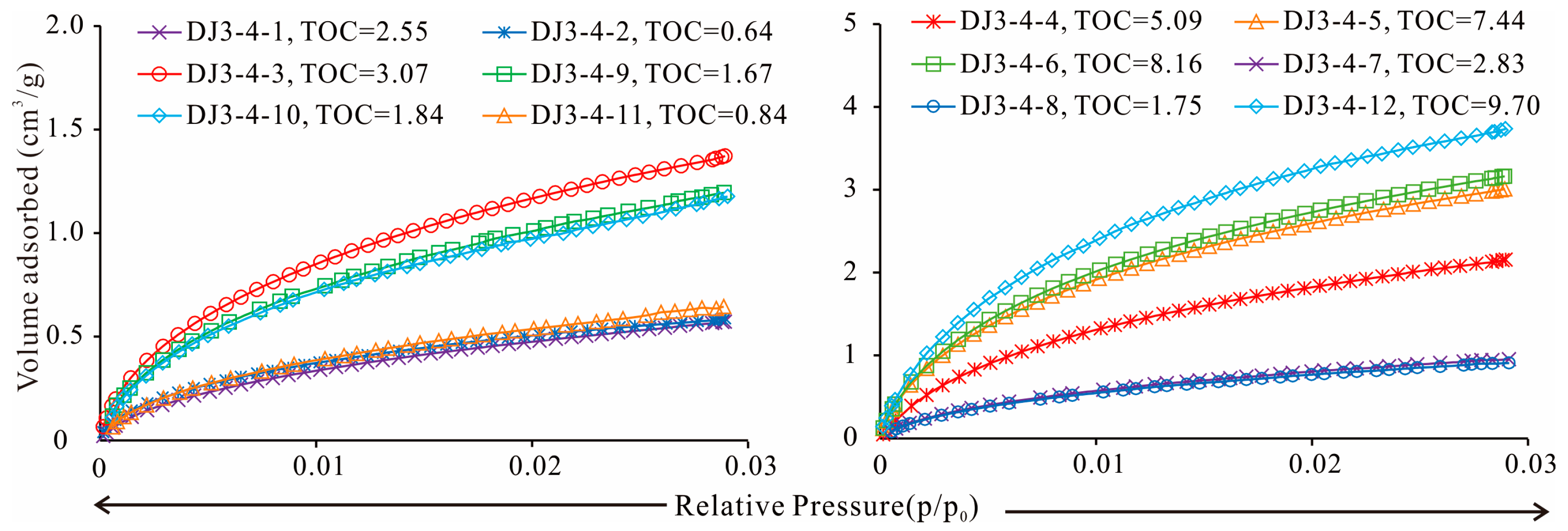

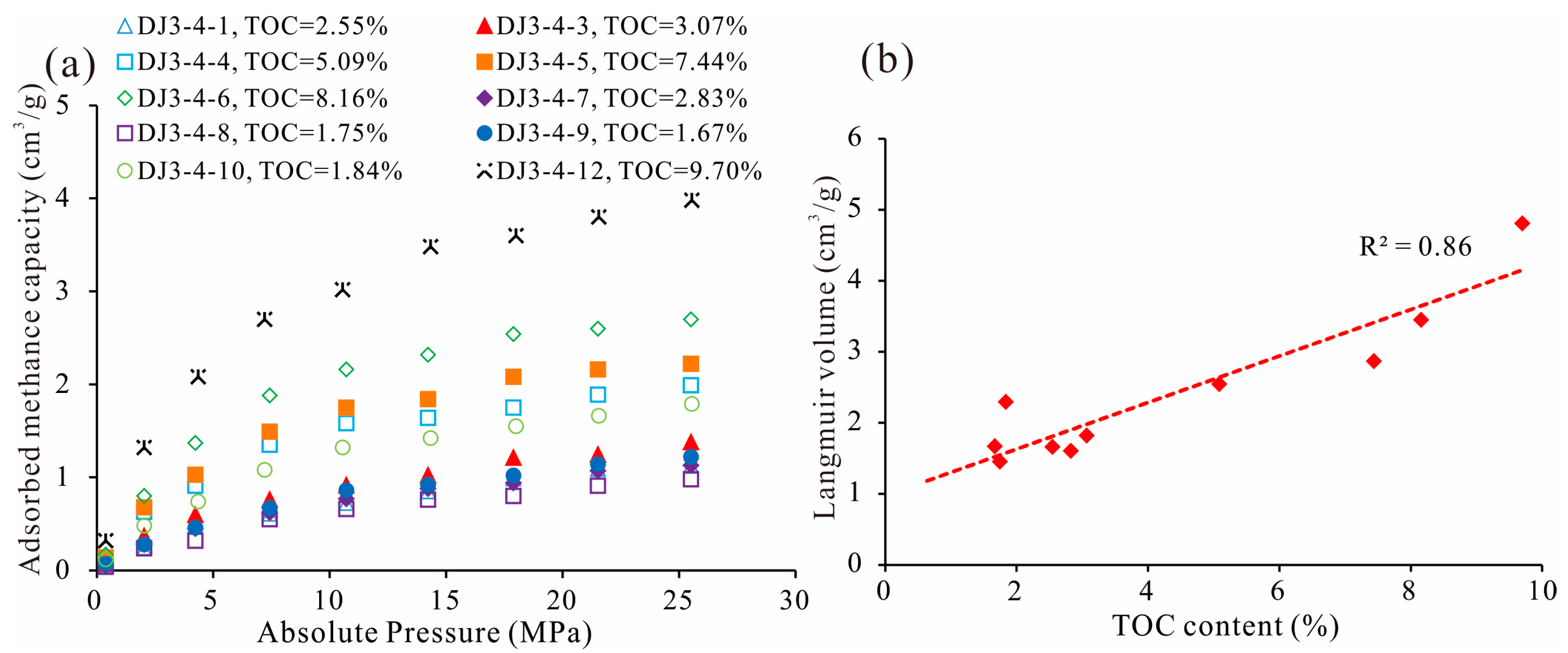
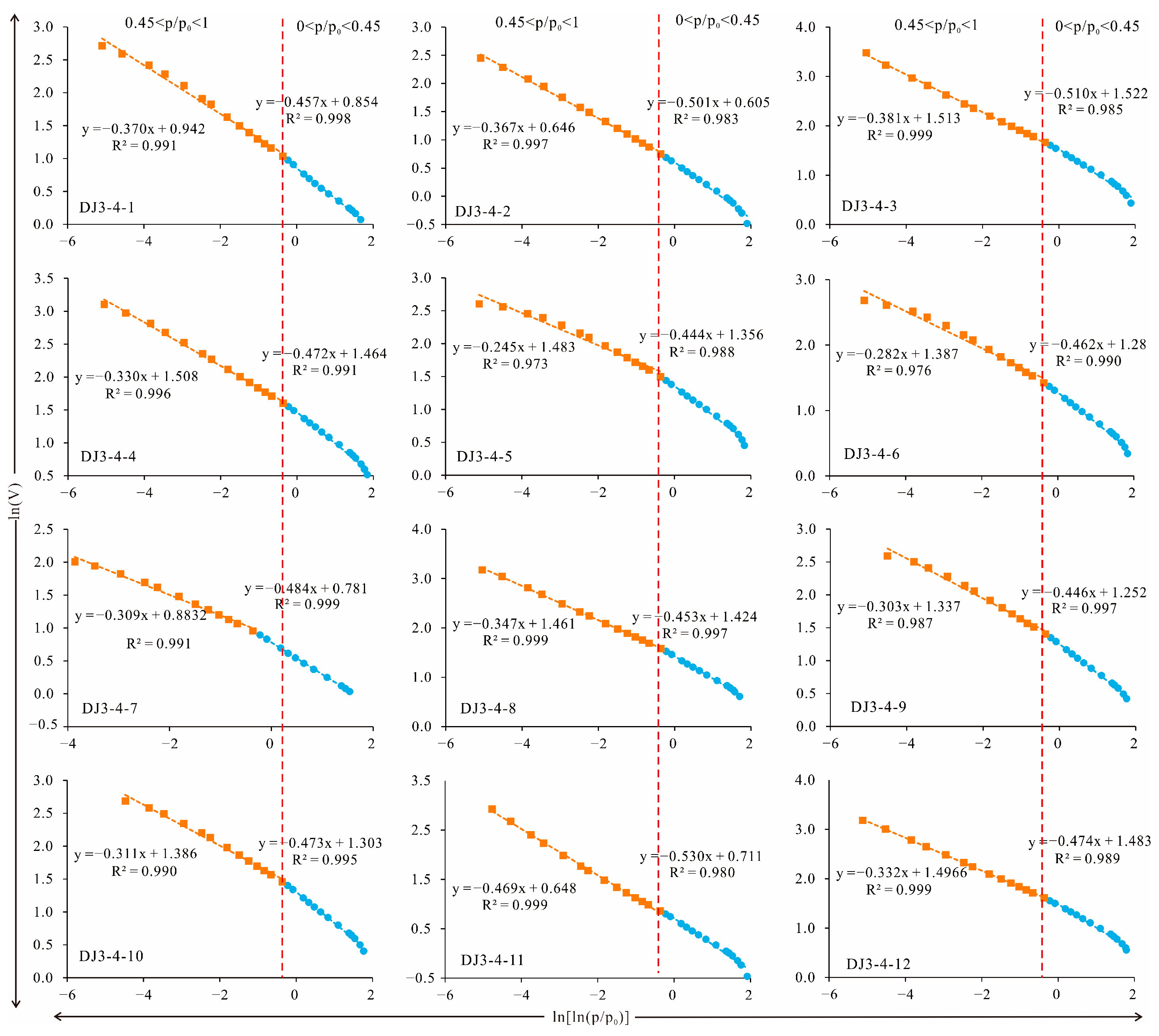
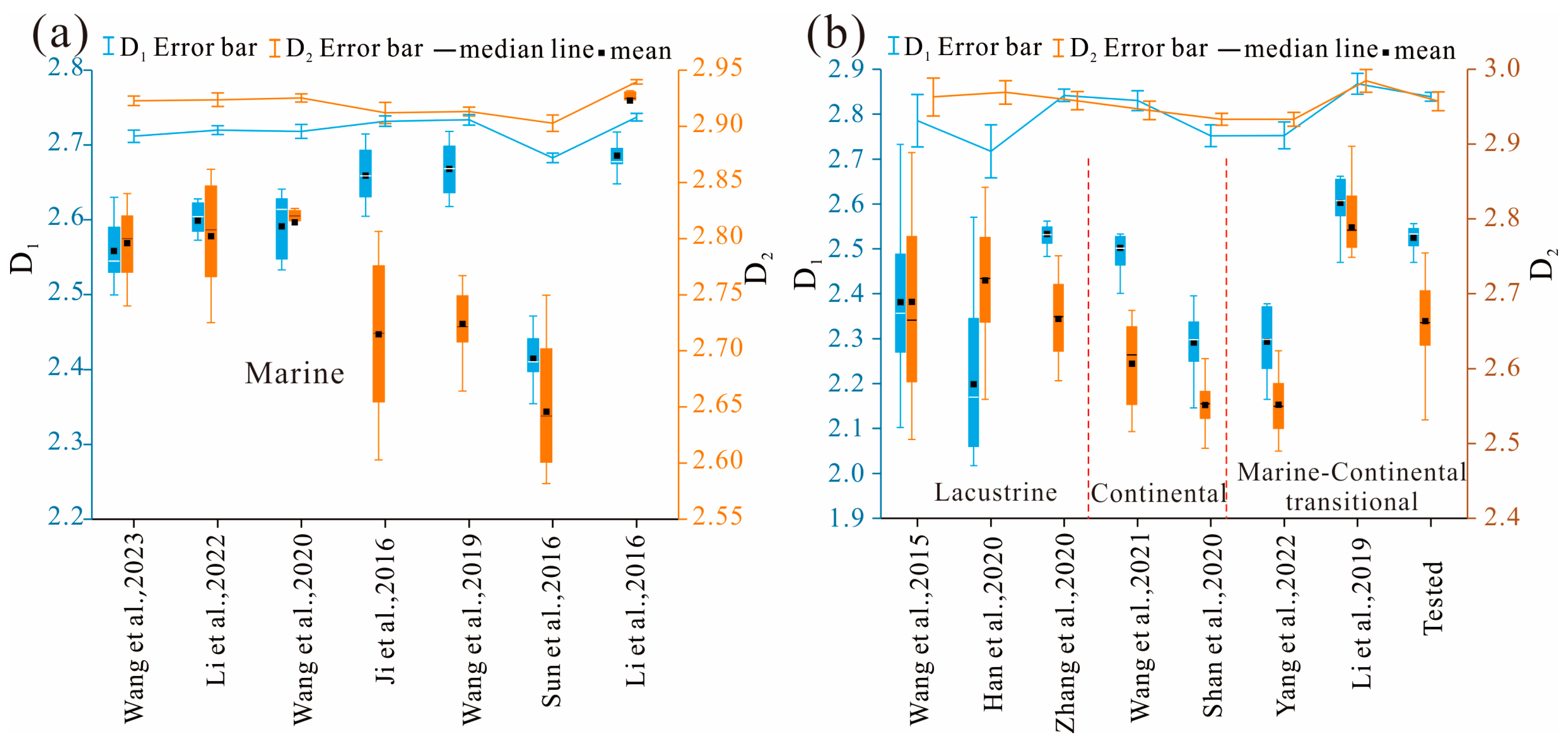
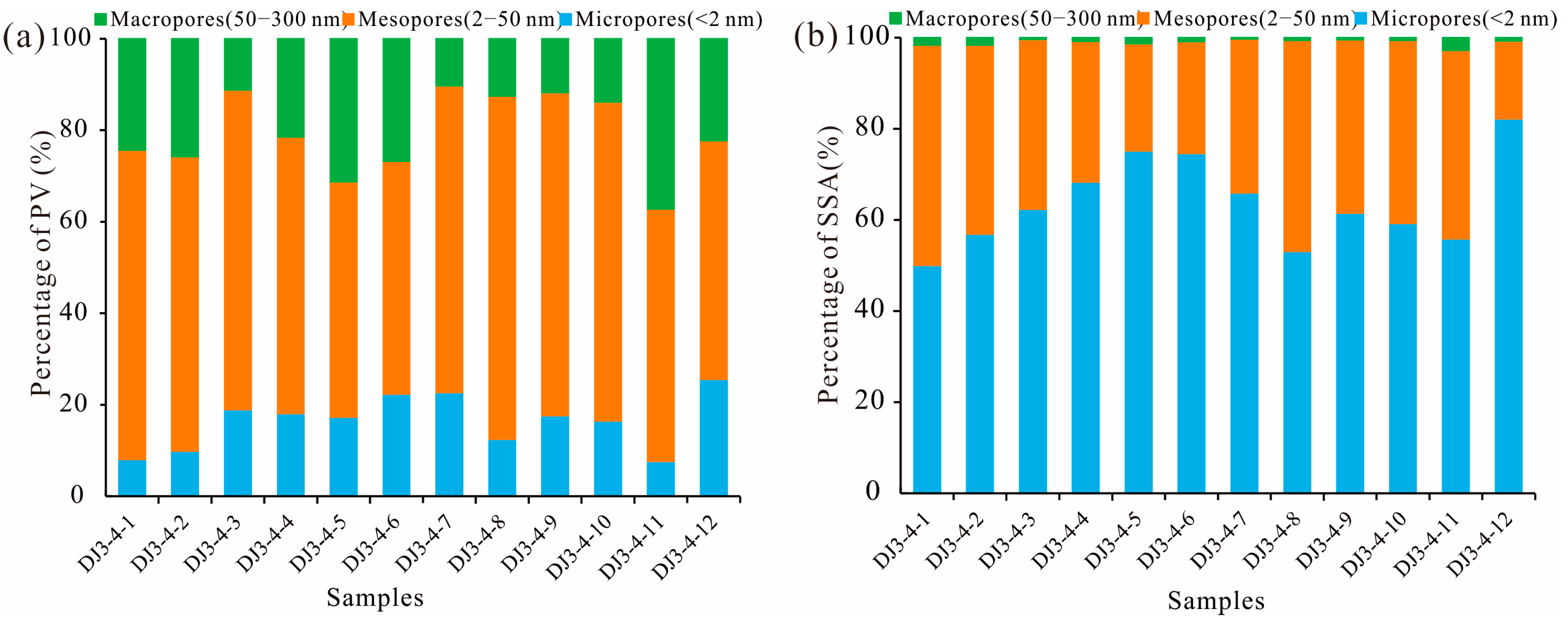
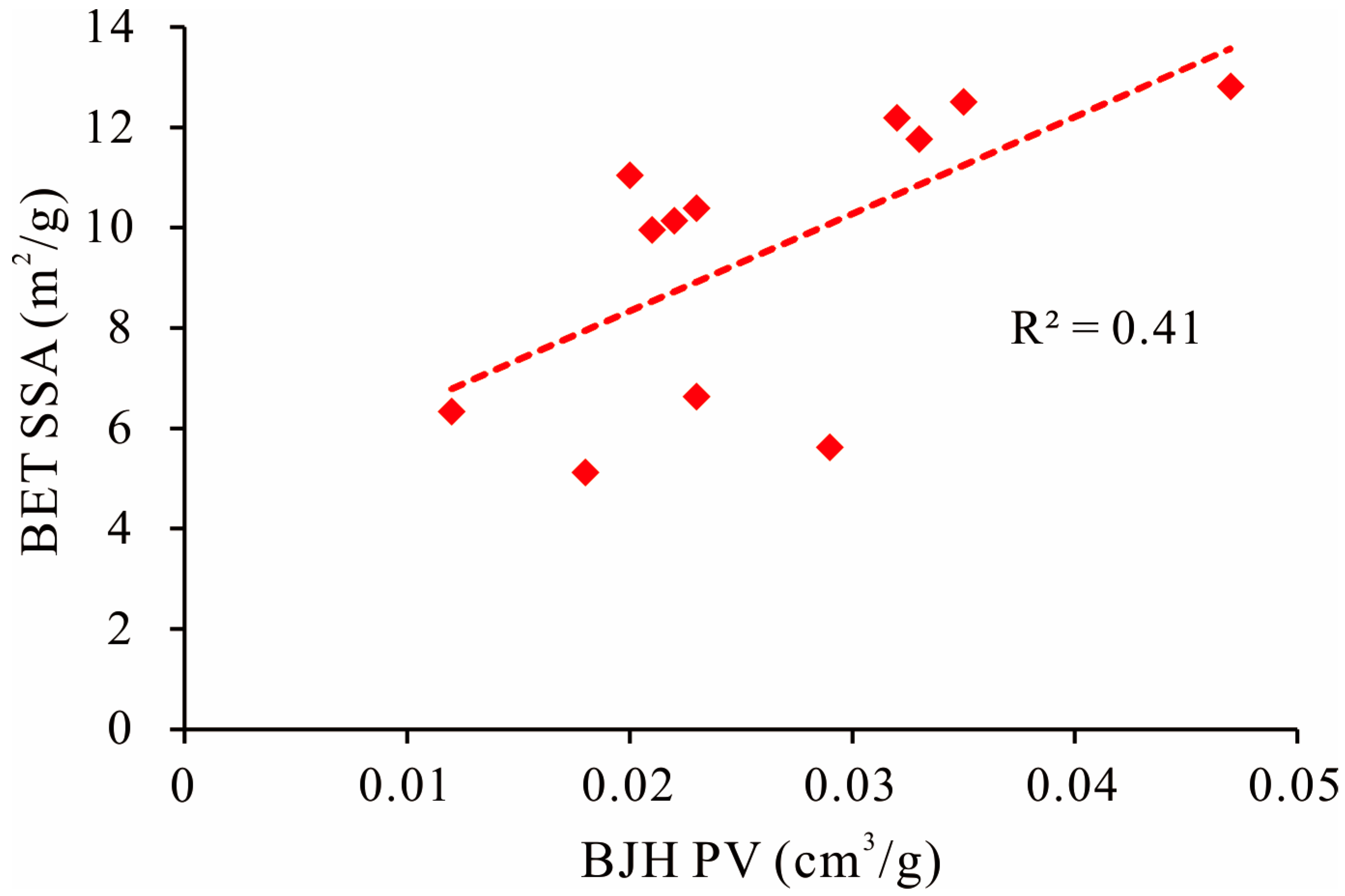
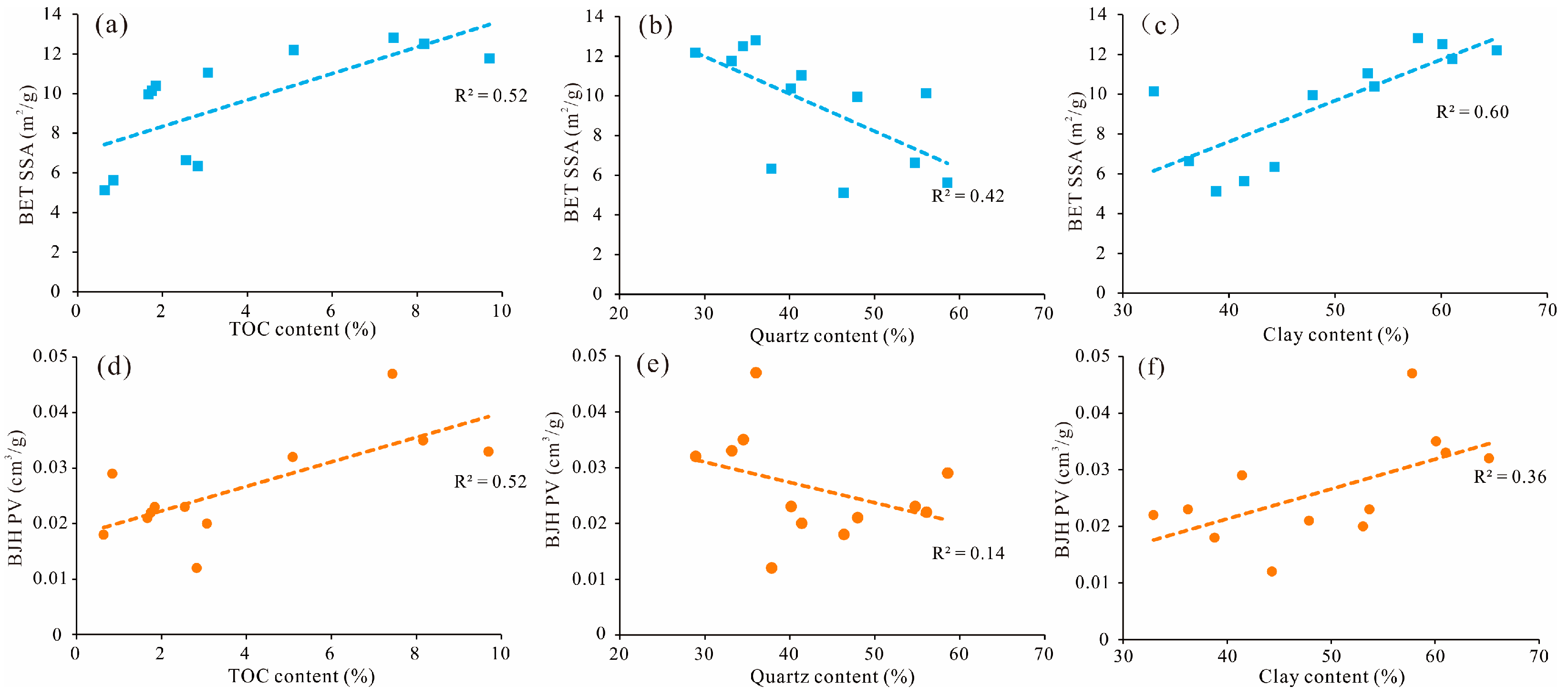


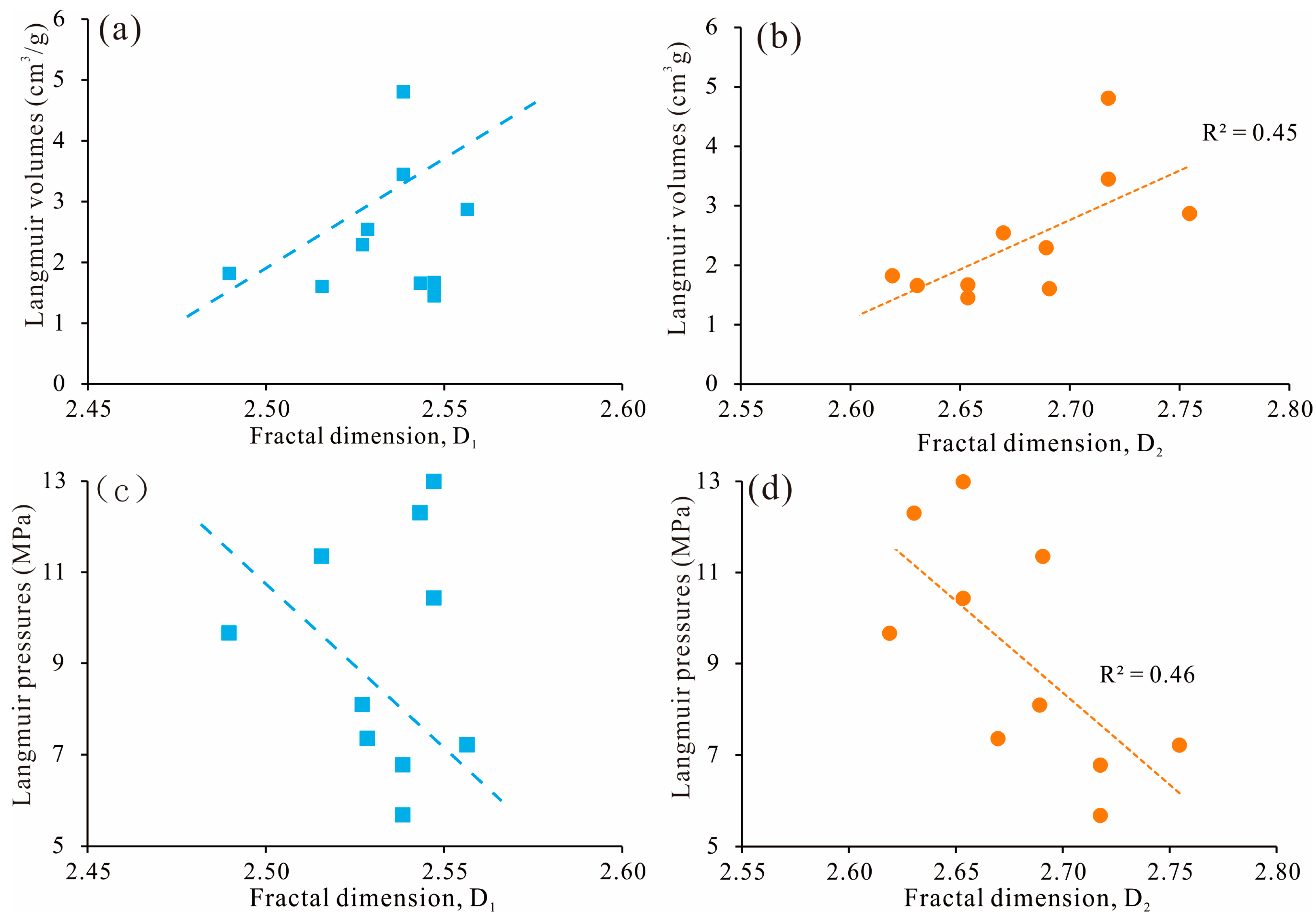
| Samples | Strata | Depth (m) | TOC (%) | Ro (%) | Quartz (%) | Total Clays (%) | Potash Feldspar (%) | Plagioclase (%) | Calcite (%) | Dolomite (%) | Pyrite (%) | Siderite (%) |
|---|---|---|---|---|---|---|---|---|---|---|---|---|
| DJ3-4-1 | Shanxi Fm. | 2138.29 | 2.55 | 2.17 | 54.77 | 36.24 | 0.00 | 0.00 | 1.14 | 4.99 | 2.87 | 0.00 |
| DJ3-4-2 | Shanxi Fm. | 2139.05 | 0.64 | 2.12 | 46.39 | 38.79 | 0.00 | 2.53 | 0.00 | 6.52 | 0.97 | 4.81 |
| DJ3-4-3 | Shanxi Fm. | 2141.39 | 3.07 | 2.17 | 41.41 | 53.07 | 0.00 | 0.00 | 0.00 | 0.00 | 1.41 | 4.11 |
| DJ3-4-4 | Shanxi Fm. | 2142.635 | 5.09 | 2.34 | 28.92 | 65.21 | 0.00 | 0.00 | 0.00 | 0.00 | 5.87 | 0.00 |
| DJ3-4-5 | Shanxi Fm. | 2143.395 | 7.44 | 2.33 | 36.03 | 57.80 | 0.00 | 1.71 | 0.00 | 1.27 | 0.63 | 2.56 |
| DJ3-4-6 | Shanxi Fm. | 2145.21 | 8.16 | 2.3 | 34.54 | 60.10 | 0.00 | 1.71 | 0.00 | 1.39 | 0.69 | 1.58 |
| DJ3-4-7 | Shanxi Fm. | 2149.19 | 2.83 | 2.29 | 37.87 | 44.31 | 0.00 | 0.00 | 11.01 | 2.55 | 4.26 | 0.00 |
| DJ3-4-8 | Shanxi Fm. | 2152.09 | 1.75 | 2.08 | 56.10 | 32.91 | 0.00 | 1.64 | 0.00 | 6.17 | 3.18 | 0.00 |
| DJ3-4-9 | Shanxi Fm. | 2153.64 | 1.67 | 2.23 | 48.00 | 47.87 | 0.00 | 0.00 | 0.00 | 1.22 | 1.15 | 1.76 |
| DJ3-4-10 | Shanxi Fm. | 2158.61 | 1.84 | 2.19 | 40.18 | 53.69 | 0.00 | 2.49 | 0.00 | 0.00 | 0.64 | 2.99 |
| DJ3-4-11 | Shanxi Fm. | 2163.1 | 0.84 | 2.13 | 58.58 | 41.42 | 0.00 | 0.00 | 0.00 | 0.00 | 0.00 | 0.00 |
| DJ3-4-12 | Shanxi Fm. | 2166.09 | 9.70 | 2.36 | 33.18 | 61.04 | 0.00 | 1.38 | 0.00 | 0.00 | 0.00 | 4.40 |
| Site | Formation | Facies | Mineral Composition | Range (%) | Mean (%) | Source |
|---|---|---|---|---|---|---|
| Northern Yunnan–Guizhou | Wufeng–Longmaxi | Marine | Clay | 16.7–39.6 | 29.0 | Wang et al., 2023 [15] |
| Quartz | 24.7–63.3 | 40.9 | ||||
| Ordos Basin | Yanchang | Continental | Clay | 39.0–46.0 | 43.0 | Wang et al., 2021 [17] |
| Quartz | 33.0–40.0 | 36.6 | ||||
| Songliao Basin | Nenjiang | Lacustrine | Clay | 42.1–64.4 | 53.8 | Zhang et al., 2020 [21] |
| Quartz | 20.1–34.7 | 26.2 | ||||
| Sichuan Basin | Niutitang | Marine | Clay | 7.8–36.2 | 20.6 | Meng et al., 2020 [42] |
| Quartz | 21.2–56.7 | 35.3 | ||||
| Fort Worth Basin | Barnett | Marine | Clay | 7.0–48.0 | 24.2 | Loucks et al., 2006 [43] |
| Quartz | 8.0–58.0 | 34.3 | ||||
| Jingmen exploration area | Wufeng–Longmaxi | Marine | Clay | 15.4–52.1 | 39.6 | Li et al., 2022 [44] |
| Quartz | 38.0–58.8 | 44.6 | ||||
| Sichuan Basin | Longmaxi | Marine | Clay | 10.2–42.2 | 21.4 | Wang et al., 2020 [45] |
| Quartz | 32.0–83.0 | 52.3 | ||||
| Songliao Basin | Qingshankou | Lacustrine | Clay | 41.0–65.9 | 54.6 | Wang et al., 2015 [46] |
| Quartz | 17.2–39.0 | 26.2 | ||||
| Eastern margin of the Ordos Basin | Shanxi | Transitional | Clay | 32.9–65.2 | 49.4 | Tested |
| Quartz | 28.9–58.6 | 43.0 |
| Samples | Strata | LP-CO2A | LT-N2A | ||||
|---|---|---|---|---|---|---|---|
| SDFT (m2/g) | VDFT (cm3/g) | DCO2 (nm) | SBET (m2/g) | VBJH (cm3/g) | DN2 (nm) | ||
| DJ3-4-1 | Shanxi Fm. | 6.036 | 0.002 | 0.349 | 6.630 | 0.023 | 3.970 |
| DJ3-4-2 | Shanxi Fm. | 6.025 | 0.002 | 0.349 | 5.118 | 0.018 | 2.455 |
| DJ3-4-3 | Shanxi Fm. | 14.163 | 0.004 | 0.349 | 11.046 | 0.020 | 4.215 |
| DJ3-4-4 | Shanxi Fm. | 22.420 | 0.007 | 0.501 | 12.189 | 0.032 | 3.966 |
| DJ3-4-5 | Shanxi Fm. | 31.358 | 0.009 | 0.349 | 12.812 | 0.047 | 3.977 |
| DJ3-4-6 | Shanxi Fm. | 33.226 | 0.010 | 0.349 | 12.509 | 0.035 | 3.967 |
| DJ3-4-7 | Shanxi Fm. | 9.533 | 0.003 | 0.551 | 6.337 | 0.012 | 4.758 |
| DJ3-4-8 | Shanxi Fm. | 9.965 | 0.003 | 0.576 | 10.138 | 0.022 | 4.362 |
| DJ3-4-9 | Shanxi Fm. | 12.957 | 0.004 | 0.517 | 9.954 | 0.021 | 4.283 |
| DJ3-4-10 | Shanxi Fm. | 12.910 | 0.004 | 0.573 | 10.386 | 0.023 | 3.977 |
| DJ3-4-11 | Shanxi Fm. | 7.044 | 0.002 | 0.479 | 5.624 | 0.029 | 3.964 |
| DJ3-4-12 | Shanxi Fm. | 38.803 | 0.011 | 0.349 | 11.763 | 0.033 | 3.960 |
| Samples | Strata | Depths | PL (MPa) | VL (cm3/g) |
|---|---|---|---|---|
| DJ3-4-1 | Shanxi Fm. | 2138.29 | 12.30 | 1.66 |
| DJ3-4-3 | Shanxi Fm. | 2141.39 | 9.66 | 1.82 |
| DJ3-4-4 | Shanxi Fm. | 2142.635 | 7.35 | 2.54 |
| DJ3-4-5 | Shanxi Fm. | 2143.395 | 7.21 | 2.87 |
| DJ3-4-6 | Shanxi Fm. | 2145.21 | 6.77 | 3.45 |
| DJ3-4-7 | Shanxi Fm. | 2149.19 | 11.35 | 1.60 |
| DJ3-4-8 | Shanxi Fm. | 2152.09 | 12.99 | 1.45 |
| DJ3-4-9 | Shanxi Fm. | 2153.64 | 10.43 | 1.67 |
| DJ3-4-10 | Shanxi Fm. | 2158.61 | 8.09 | 2.29 |
| DJ3-4-12 | Shanxi Fm. | 2166.09 | 5.68 | 4.81 |
| Samples | Strata | p/p0 = 0~0.45 | p/p0 = 0.45~1.0 | ||||
|---|---|---|---|---|---|---|---|
| A1 | R2 | D1 | A2 | R2 | D2 | ||
| DJ3-4-1 | Shanxi Fm. | −0.457 | 0.998 | 2.543 | −0.370 | 0.991 | 2.631 |
| DJ3-4-2 | Shanxi Fm. | −0.501 | 0.983 | 2.499 | −0.367 | 0.997 | 2.633 |
| DJ3-4-3 | Shanxi Fm. | −0.510 | 0.985 | 2.490 | −0.381 | 0.999 | 2.619 |
| DJ3-4-4 | Shanxi Fm. | −0.472 | 0.991 | 2.529 | −0.330 | 0.996 | 2.670 |
| DJ3-4-5 | Shanxi Fm. | −0.444 | 0.988 | 2.557 | −0.245 | 0.973 | 2.755 |
| DJ3-4-6 | Shanxi Fm. | −0.462 | 0.990 | 2.539 | −0.282 | 0.976 | 2.718 |
| DJ3-4-7 | Shanxi Fm. | −0.484 | 0.999 | 2.516 | −0.309 | 0.991 | 2.691 |
| DJ3-4-8 | Shanxi Fm. | −0.453 | 0.997 | 2.547 | −0.347 | 0.999 | 2.654 |
| DJ3-4-9 | Shanxi Fm. | −0.446 | 0.997 | 2.547 | −0.303 | 0.987 | 2.654 |
| DJ3-4-10 | Shanxi Fm. | −0.473 | 0.995 | 2.527 | −0.311 | 0.990 | 2.689 |
| DJ3-4-11 | Shanxi Fm. | −0.530 | 0.980 | 2.470 | −0.469 | 0.999 | 2.531 |
| DJ3-4-12 | Shanxi Fm. | −0.474 | 0.989 | 2.539 | −0.332 | 0.999 | 2.718 |
| Samples | PV (cm3/g) | SSA (m2/g) | ||||||
|---|---|---|---|---|---|---|---|---|
| Micropore | Mesopore | Macropore | Total | Micropore | Mesopore | Macropore | Total | |
| DJ3-4-1 | 0.002 | 0.017 | 0.006 | 0.025 | 6.29 | 6.09 | 0.20 | 12.583 |
| DJ3-4-2 | 0.002 | 0.012 | 0.005 | 0.019 | 6.33 | 4.62 | 0.18 | 11.126 |
| DJ3-4-3 | 0.004 | 0.017 | 0.003 | 0.024 | 14.71 | 8.79 | 0.09 | 23.593 |
| DJ3-4-4 | 0.007 | 0.024 | 0.008 | 0.039 | 22.99 | 10.42 | 0.27 | 33.684 |
| DJ3-4-5 | 0.010 | 0.029 | 0.017 | 0.056 | 32.13 | 10.06 | 0.58 | 42.761 |
| DJ3-4-6 | 0.010 | 0.023 | 0.012 | 0.045 | 33.25 | 10.94 | 0.39 | 44.590 |
| DJ3-4-7 | 0.003 | 0.010 | 0.001 | 0.014 | 10.65 | 5.45 | 0.05 | 16.154 |
| DJ3-4-8 | 0.003 | 0.018 | 0.003 | 0.024 | 9.92 | 8.66 | 0.11 | 18.697 |
| DJ3-4-9 | 0.004 | 0.018 | 0.003 | 0.025 | 13.77 | 8.50 | 0.11 | 22.382 |
| DJ3-4-10 | 0.005 | 0.019 | 0.004 | 0.027 | 13.74 | 9.31 | 0.14 | 23.184 |
| DJ3-4-11 | 0.002 | 0.017 | 0.012 | 0.031 | 7.31 | 5.41 | 0.37 | 13.080 |
| DJ3-4-12 | 0.011 | 0.023 | 0.010 | 0.045 | 38.80 | 8.07 | 0.35 | 47.220 |
Disclaimer/Publisher’s Note: The statements, opinions and data contained in all publications are solely those of the individual author(s) and contributor(s) and not of MDPI and/or the editor(s). MDPI and/or the editor(s) disclaim responsibility for any injury to people or property resulting from any ideas, methods, instructions or products referred to in the content. |
© 2023 by the authors. Licensee MDPI, Basel, Switzerland. This article is an open access article distributed under the terms and conditions of the Creative Commons Attribution (CC BY) license (https://creativecommons.org/licenses/by/4.0/).
Share and Cite
Wang, D.; Xie, Z.; Hu, H.; Wang, T.; Deng, Z. Pore Structure and Fractal Characteristics of Marine–Continental Transitional Black Shales: A Case Study of the Permian Shanxi Formation in the Eastern Margin of the Ordos Basin. Processes 2023, 11, 1424. https://doi.org/10.3390/pr11051424
Wang D, Xie Z, Hu H, Wang T, Deng Z. Pore Structure and Fractal Characteristics of Marine–Continental Transitional Black Shales: A Case Study of the Permian Shanxi Formation in the Eastern Margin of the Ordos Basin. Processes. 2023; 11(5):1424. https://doi.org/10.3390/pr11051424
Chicago/Turabian StyleWang, Daxing, Zhitao Xie, Haiyan Hu, Tao Wang, and Ze Deng. 2023. "Pore Structure and Fractal Characteristics of Marine–Continental Transitional Black Shales: A Case Study of the Permian Shanxi Formation in the Eastern Margin of the Ordos Basin" Processes 11, no. 5: 1424. https://doi.org/10.3390/pr11051424
APA StyleWang, D., Xie, Z., Hu, H., Wang, T., & Deng, Z. (2023). Pore Structure and Fractal Characteristics of Marine–Continental Transitional Black Shales: A Case Study of the Permian Shanxi Formation in the Eastern Margin of the Ordos Basin. Processes, 11(5), 1424. https://doi.org/10.3390/pr11051424







